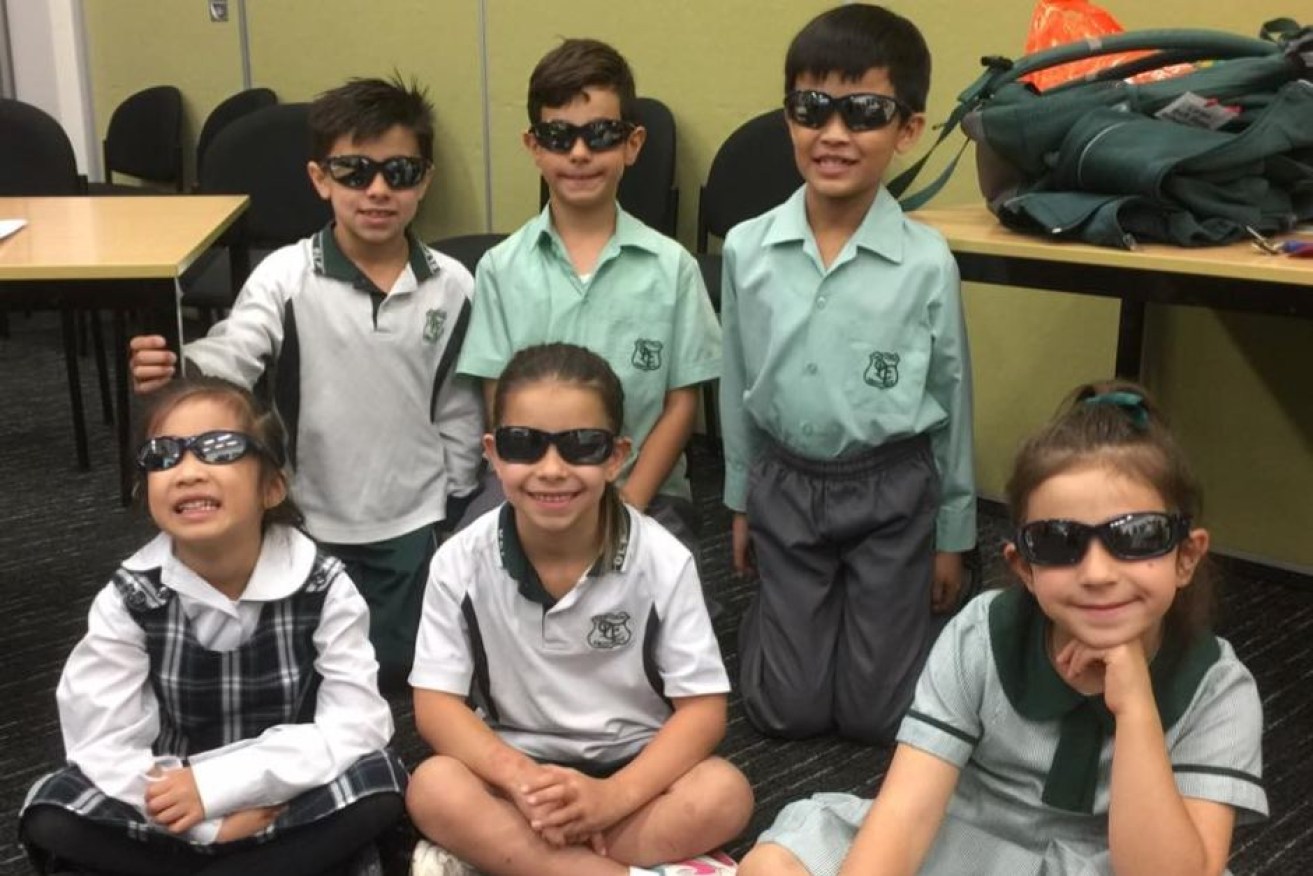UV exposure causing serious eye disease and damage in children, doctors warn

Our Lady of Fatima Catholic Primary School in Kingsgrove has made sunglasses compulsory. Photo: ABC/Facebook
When Victoria Hill’s daughter Phoebe complained about sore, itchy and bloodshot eyes this summer, the Sydney mum thought it was an allergic reaction to dust or mould.
But a trip to the ophthalmologist revealed Phoebe had eye damage caused by ultraviolet light.
The membrane around her irises in both eyes had permanently thickened, and the doctor warned any further growth could lead to vision loss.
“This was an absolute shock,” Ms Hill said. “I was one of those mums that made my kids wear sunglasses from the chemist, wear hats and sunscreen.
“But the damage was done in the water, with the light reflecting off the water.”
Phoebe is one of an alarming number of young children showing the first signs of eye disease and damage caused by UV light.
The most common consequences include damage to the front surface of the eye, called pterygia and pingueculae, skin cancers on the eyelid margin, and some types of cataracts.
The Royal Australian and New Zealand College of Ophthalmologists (RANZCO) this week urged parents to properly protect their children’s eyes and called on schools to implement a “no hat, no sunglasses, no play” policy.
Phoebe’s paediatric ophthalmologist Dr Shanel Sharma said she had seen an increase in children presenting with eye damage caused by UV light this summer compared with previous years.
“Children often present with early stages of disease — red, inflamed, irritated sore eyes, which is often misdiagnosed as conjunctivitis,” Dr Sharma told ABC Radio Sydney.
“A lot of the damage that is occurring in childhood is just like skin cancer, which is undetectable until later on.”
Ignore fashion, think protection
In a study co-authored by Dr Sharma and published in the American Journal of Ophthalmology, 29 per cent of children aged nine to 11 were found to have eye damage from the sun.
That figure increased in ages 12 to 15 years old, where four in five teenagers or 81 per cent showed signs of eye damage.
“Unfortunately so far sunglasses have been made and marketed as a fashion accessory,” Dr Sharma said.
“We look more at how cool it looks or what the fashion stars are wearing, but we really need to be thinking about eye protection so we can protect these diseases, which ultimately lead to surgery.”
Push to make sunglasses compulsory at school
All sunglasses sold in Australia must be tested and labelled with an Australian/New Zealand standard classification from lens category zero (fashion spectacles) to four (special-purpose sunglasses).
RANZCO recommends category three sunglasses for children that offer a good level of UV protection and provide a high level of sun glare reduction.

Phoebe now wears goggles at the beach to protect her eyes from sun reflection. Photo: ABC/Victoria Hill
They also advise parents to ensure children wear “broad brimmed hats when they are outdoors” as well as sunglasses.
Ms Hill is planning on petitioning Phoebe’s eastern suburbs school to make sunglasses a compulsory part of the uniform.
If her request is rejected, as previous applications to the school have been, Ms Hill said she will make a case to the parents’ committee.
“The school has a hat policy, so it’s really frustrating as parents,” she said.
“I think sunglasses should be compulsory, otherwise it’s hard for kids to wear them.
“They don’t want to be the only one wearing sunglasses in the playground.”
Choose sunglasses that:
- Are rated Category 3 of the Australian Standards for UV protection.
- Have a wraparound frame, designed to minimise unfiltered side light entering the eye.
- Have lenses with UV 400 protection.
- Have lens coatings to block reflected light from entering the eye.
- Have polarised lenses.Source: RANZCO
– ABC








